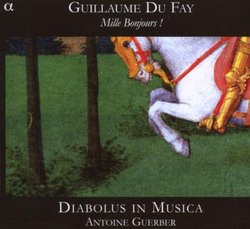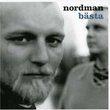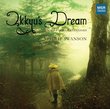| All Artists: Guillaume Dufay, Conrad Paumann, Antoine Guerber, Frédéric Betous, Andrès Rojas-Urrego, Diabolus in Musica, Aï Lund-Lavoipierre, Raphael Boulay Title: Guillaume Du Fay: Mille Bonjours! Members Wishing: 1 Total Copies: 0 Label: ALPHA PRODUCTIONS Original Release Date: 1/1/2008 Re-Release Date: 1/8/2008 Genres: Pop, Classical Styles: Vocal Pop, Opera & Classical Vocal, Chamber Music, Forms & Genres, Ballads, Rondos, Historical Periods, Classical (c.1770-1830) Number of Discs: 1 SwapaCD Credits: 1 UPC: 3760014191169 |
Search - Guillaume Dufay, Conrad Paumann, Antoine Guerber :: Guillaume Du Fay: Mille Bonjours!
 | Guillaume Dufay, Conrad Paumann, Antoine Guerber Guillaume Du Fay: Mille Bonjours! Genres: Pop, Classical
Guillaume Dufay is one of the key representatives of the French musical genius. His masterful work is a comprehensive and brilliant apotheosis of the middle ages. |
Larger Image |
CD DetailsSynopsis
Album Description Guillaume Dufay is one of the key representatives of the French musical genius. His masterful work is a comprehensive and brilliant apotheosis of the middle ages. Similar CDs
|
CD ReviewsDuFay mille bonjours H. Chr Albertz | Den Haag, Netherlands | 02/10/2008 (5 out of 5 stars) "highly recommendabale, this excellent cd of the most outstanding composer of his age: elegant, melodious music, polyphonic, but not in an austere way; fluent and incredible harmonious, fascinating music. The execution? Superb. Grateful to have been able to buy this rich, highly rewarding music! HCA" Music from the 15th Century's Most Renowned Performer EquesNiger | Prague, Czech Republic | 05/06/2008 (4 out of 5 stars) "Guillaume Du Fay started from modest beginnings, the illegitimate son of a priest and a "lady", but rose quickly through the ranks in the Church and became the early-Renaissance's most celebrated and popular composer. While his life was dedicated to the church, his compositions weren't entirely liturgical. In "Mille Bonjours", we are treated to an extensive sampling of his secular works - works for which he became the equivalent of a Renaissance period "pop star". While some liturgical elements are evident in the compositions, this is music purely for the masses (as in general populace), and reflects the style that came to represent the Burgundian School, of which Du Fay was a founder. His work was widely played and copied throughout Europe in his day, and for about a century thereafter - all the more impressive since the transposition of music into written sheet music hadn't been effected in that day. The composition and execution of this compilation is top notch." These Devils OWN Dufay! Giordano Bruno | Wherever I am, I am. | 09/26/2008 (5 out of 5 stars) "Without a moment's doubt, I can say that this is the best-performed CD of Dufay's secular chansons that I've ever heard, with 19 of those supremely sophisticated miniature masterpieces assembled in a concert progress from love-sickness to joie-de-vivre. This recording is a perfect companion to Diabolus in Musica's CD of Dufay's most memorable mass, Missa Se La Face Ay Pale (which I've reviewed previously. Wonder of wonders, the chanson Se La Face Ay Pale is included on this disk, in an elaborated "keyboard" setting from a tablature manuscript, played on an instrument that worked somewhat like a harpsichord and sounds rather like a harp on energy drinks. The singers have to share glory in this performance with some extraordinarily skillful playing of late Medieval instruments: vielle (fiddle) and Burgundian harp especially. But there's plenty of glory to be shared.
The name of this ensemble - Diabolus in Musica - would probably get this CD banned from certain libraries in Alaska, but actually the term refers to the interval of the tritone (the augmented fourth) which either in chords or in scale passages caused innumerable headaches for polyphonists, always sounding "wrong' to their ears. The solution involved something called "musica ficta", the addition of a sharp or a flat to avoid the tritone. Such ficta were seldom notated; the performer was expected to recognize the need and to know the rules. Rest assured that Ensemble Diabolus in Musica is totally avoidant of devilish dissonances. The secular chanson repertoire, from Machaut to Dufay, is the prime glory of Medieval music, as pre-eminent as the madrigal in the late Renaissance or the polka at a Minnesota family reunion." |

 Track Listings (19) - Disc #1
Track Listings (19) - Disc #1


